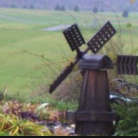
With a big snowstorm predicted for later today, we know it can be mesmerizing to watch the snow fall. As you gaze out at those huge white flakes floating down, perhaps your eyes track one flake from high up until it settles on top of another, each one gradually adding to the depth. And then you stand transfixed at the shower of multitudinous beautiful and one-of-a-kind flakes fluttering down… gently, softly, quietly… It’s such a beautiful, peaceful scene, isn’t it?
Contemplating the peace and quiet of a gentle snowfall reminds me of a Scripture verse I love, “Be still, and know that I am God...” (Psalm 46:10 NIV) In the stillness, we can see His majesty in creation all around us – in people and in nature. We can hear His still small voice speaking to our heart. In the stillness, we can consider how He would want us to handle a certain situation. And, as we take time to ponder, we begin to see how various aspects of life fit together to help us understand the overall picture.
Be still… and know that God has it all under control. He loves each of us deeply and has our best interests at heart… even when we go through the storm and upheaval of some great difficulty. Just like Jesus’ disciples.
After Jesus had taught the crowds in His “Sermon on the Mount,” He and the disciples went out in a boat on the Sea of Galilee to get away from the boisterous crowds looking for more. Suddenly, a storm came up, rocking their boat as waves washed over the sides, almost flooding them out. Even after having heard Jesus preach all day about faith and trusting God, His disciples promptly began to fret and worry in the midst of the storm… so like us, aren’t they?! On waking the sleeping Jesus, they asked, “Don’t you care if we drown?” Jesus simply got up and said, “Quiet! Be still!” The winds backed off and the big waves shrank right down to gentle calm ripples. Wouldn’t you have liked to have been there? Just like that, there was peace from His simple command! (Luke 4:35-41 NIV)
Undoubtedly, it’s a challenge for us to “be still…” I know it’s hard for me to make quiet time to contemplate God’s goodness toward me… toward us. Life is so busy, so hectic, filled with so many demands on our time and energy. We need time to be still… time to stop and reflect… time to pause amidst the rush… time to get away from the challenges… time to just be still and listen to what God has to say within our heart… and time to quiet the fear and anxiety which so often grips our heart.
I know I need to take time to be still… to read His word and pray… to ask for His guidance and wisdom amidst all that I face in this busy hectic world.
Be still… enjoy the peace and quiet… know that He is God… and let Him be your refuge.
Be Still and Know
Linda A. Roorda
Be still and know that He is my God.
He is my rock, my firm foundation.
Upon His word I stand secure
Trusting the wisdom found only in Him.
Be still and rest in mercy and grace.
For humble Love from heaven above
Dwelt among us to seek and to save
Whose blood was shed for me on the cross.
Be still and know He embodies Love
He bought my soul with His precious gift
That I’d find hope in His selfless act
As He redeems with mercy and grace.
Be still and pause to contemplate thanks
With grateful heart as blessings abound
Knowing their source is heavenly love
As God above graciously bestows.
Be still my soul within life’s tempests
For He is my refuge, a shelter indeed
He calms the storms, I rest in His arms
To find His peace envelopes my heart.
Be still and gaze with reverence and awe
On One whose sovereign grandeur is revealed
Bring joyful songs of worship and praise
For He is God and He alone reigns.
Be still and hear serenity’s voice
Within my heart, throughout creation
For in His will others we shall serve
That we might honor and glorify Him.
Be still and know our God is faithful
He changes not though fickle we be
His truth remains profound and secure
That we may humbly His wisdom reflect.
~~
- Read more...
- 0 comments
- 402 views

